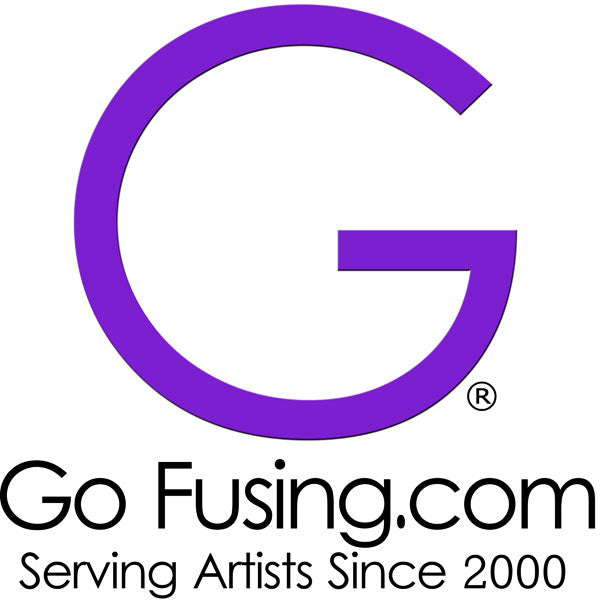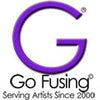
What is a COE 96 Precut Glass Wafer?
are an accessory glass component used in the Glass Fusion process. Go Fusing's precut glass wafer shapes are fusible glass shapes made from original Spectrum glass formulas that are now known as COE 96 Oceanside Compatible glass powder. Our line of COE 96 compatible glass wafer shapes are precut from a sheet of glass adhesive. Then a layer of glass powder is bonded to each side of the precut shape during a heating cycle up to around 160 to 180 degrees Fahrenheit. After cooling the shapes, they become firm. Once hardened they are then referred to as a glass wafer.
What is the Advantage of using a COE 96 Glass Wafer versus a Precut Glass Shape?
- You can cut the wafers with scissors or a razor knife to customize the shape to your fused glass design.
- A precut wafer is not more than 1 mm in thickness so they add very little volume or weight to your design.
Examples: Making a light weight Christmas ornament or cutting designs in half to make more or a custom layout. - You can easily customize the color and shading of a glass wafer by adding a light layer of COE 96 glass powder frit.
Example: Adding a green powder to just the stem area of a pumpkin. - You can add a shimmery effect by sifting mica powder over a wafer, wiadminth or without adding clear powder
- You can overlay or stack glass wafers to intensify color or create a unique design story.
- Precut Glass Wafers can have very intricate designs like a filigree pumpkin or open areas like in an angel wing.
How to integrate a glass wafer into your fused glass design:
There are several ways to kiln fire the powder wafers and below will be recommended firing schedules for each method:
* Method 1. You can fire a glass wafer by themselves on a kiln washed shelf but there will be some shrinkage of the wafer, especially if fired to hot.
* Method 2. You can fire a glass wafer on top of a layer of glass but if they are fired too hot, this will also produce some shrinkage.
* Shrinkage can be reduced significantly by making sure you add a glass powder base layer and/or with a top layer. This also gives them a more firm but thin body overall.
Note: The next two options cover the wafer with a either a sheet of glass or firing between two layers of glass. It is important to allow the binders from the precut shape, cut from the glue sheet, to escape from under the glass.
Method 3. You can fire a glass wafer between layers of glass but it is recommended to Tack Fuse the precut wafer to one layer of glass first as this will allow the binders to burn off, leaving just the glass design. Then if you wish to cover with another layer of glass, sprinkle a layer of clear powdered glass frit over the entire surface before placing the clear glass cap. This will help avoid bubbles from forming between the layers of glass.
You will know you have enough glass powder when you can no longer see the pre-fired wafer.
Method 4. You can place a glass wafer on a prepared kiln shelf and then place a piece of glass over them and this too should reduce shrinkage of the wafer.
This method is great if you are using a Wissmach Luminescent which requires being face down to not burn off the shiny coating or if you are wanting to use a textured surface mold.
Note: You can pre-build projects on a fiber paper or directly on a fiber kiln shelf treated with mold release. Because the fiber is textural it helps to allow the binders to escape over a solid ceramic kiln shelf.
What are the Kiln Firing Schedules for COE96 Glass Wafers?
Initial firing of precut glass wafers requires slow and low temperatures to burn off the binders from the glue and leaving the glass powder shape bonded to the base glass layer.
(dph = degrees per hours)
(dF = degrees Fahrenheit)
TACK FUSE Firing Schedule:
Kiln Ramp Up: 200 dph at 1000 dF hold 45 minutes.
Tack Fuse Glass: 500 dph at 1335 dF hold 5 minutes.
Annealing Glass: Turn off the kiln and open at 125 degrees
FULL FUSE Firing Schedule:
Ramp Up: 200 dph at 1000 dF hold 60 minutes.
2nd Stage: 50 dph at 1225 dF hold 25 minutes.
Fusing Stage: 250 dph at 1440 dF hold 10 to 15 minutes.
Ramp Down: AFAP to 900 dF hold 45 min
Turn off the kiln and open at 125 degrees
Safety Note 1: Burning off binders can smell and it is advisable to vent your kiln and kiln area during the Ramp Up portion of the kiln schedule.
Safety Note 2: you should always wear at least an N95 mask when using glass powers or mica powders. (Mask should be worn during the sifting and during the clean up to keep from breathing glass powders).
- Choosing a selection results in a full page refresh.
!
